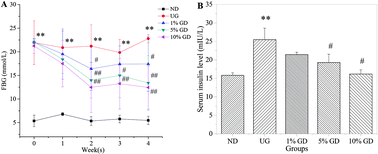Gynura divaricata ameliorates hepatic insulin resistance by modulating insulin signalling, maintaining glycolipid homeostasis and reducing inflammation in type 2 diabetic mice
Abstract
Diabetes mellitus, one of the fastest growing epidemics worldwide, has become a serious health problem in modern society. Gynura divaricata (GD), an edible medicinal plant, has been shown to have hypoglycaemic effects. The molecular mechanisms by which GD improves hepatic insulin resistance (IR) in mice with type 2 diabetes (T2D) remain largely unknown. The aerial parts of GD were prepared in a lyophilized powder, which was added into the diet of T2D mice for 4 weeks. GD could result in an obvious decrease in fasting blood glucose and insulin levels in T2D mice. Meanwhile, the underlying mechanisms involved in the insulin-signalling pathway, glucose metabolism, lipid metabolism and inflammatory reaction in the liver tissue were also investigated by western blot, which indicated that GD further ameliorated hepatic IR by activating the PI3K/p-AKT pathway, decreasing the levels of hepatic phosphoenolpyruvate carboxykinase and glucose-6-phosphatase and increasing the levels of glucokinase and peroxisome proliferator-activated receptor-γ in the livers of T2D mice. GD has the potential to alleviate both hyperglycaemia and hepatic IR in T2D mice. Therefore, GD might be a promising functional food or medicine for T2D treatment.



 Please wait while we load your content...
Please wait while we load your content...